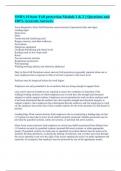OSHA 10 hour Fall protection Module 1 & 2 || Questions and
100% Accurate Answers.
Areas Required to Have Fall Protection correct answers Unprotected sides and edges
Leading edges
Hoist areas
Holes
Formwork and reinforcing steel
Ramps, runways, and other walkways
Excavations
Dangerous equipment
Overhand bricklaying and related work
Roofing work on low-slope roofs
Roofs
Pre-cast concrete erection
Residential construction
Wall openings
Walking/working surfaces not otherwise addressed
Duty to Have Fall Protection correct answers Fall protection is generally required when one or
more employees have exposure to falls of six feet or greater to the lower level.
Surfaces must be inspected before the work begins.
Employees are only permitted to be on surfaces that are strong enough to support them.
case correct answers Employers are required to assess the workplace to determine if the
walking/working surfaces on which employees are to work have the strength and structural
integrity to safely support workers. Employees are not permitted to work on those surfaces until
it has been determined that the surfaces have the requisite strength and structural integrity to
support workers. Once employers have determined that the surface is safe for employees to work
on, the employer must select one of the available options for the work operation if a fall hazard is
present.
Leading Edge Work correct answers Each employee who is constructing a leading edge six feet
(1.8 meters) or more above lower levels shall be properly protected. Suitable protection may be
provided by guardrail systems, safety net systems, or personal fall arrest systems.
Hoist Areas correct answers Each employee in a hoist area shall be protected from falling 6 feet
(1.8 meters) or more by guardrail systems, personal fall arrest systems, or other appropriate
means. If guardrail systems (or chain gate or guardrail) or portions thereof must be removed to
facilitate hoisting operations, as during the landing of materials, and a worker must lean through
the access opening or out over the edge of the access opening (to receive or guide equipment and
materials, for example), that employee must be protected by one of the appropriate means.
, Formwork and Re-Bar correct answers During formwork or re-bar assembly employees shall be
protected from falls of six feet or more by personal fall arrest systems, safety net systems, or
positioning device systems.
Ramps, Runways, and Walkways correct answers Each employee using ramps, runways, and
other walkways shall be protected from falling 6 feet (1.8 meters) or more.
Excavations correct answers Each employee at the edge of an excavation 6 feet (1.8 meters) or
deeper shall be protected from falling by guardrail systems, fences, barricades, or cover, when
the excavations are not readily seen because of plant growth or other visual barrier.
Where walkways are provided to permit employees to cross over excavations, guardrails are
required on the walkway if it is 6 feet (1.8 meters) or more above the excavation.
Dangerous Equipment correct answers Each employee working above dangerous equipment
must be protected from falling into or onto the dangerous equipment by guardrails systems or by
equipment guards even in those cases where the fall distance is less than 6 feet (1.8m).
Overhand Bricklaying correct answers Except as otherwise provided in the OSHA Fall
Protection Standards, each employee performing overhand bricklaying and related work 6 feet
(1.8 m) or more above lower levels, shall be protected from falling by guardrail systems, safety
net systems, personal fall arrest systems, or shall work in a controlled access zone.
Low-Sloped Roof Work correct answers Each employee engaged in roofing activities on low-
slope roofs, with unprotected sides and edges six feet or more above lower levels, shall be
protected from falling by guardrail systems, safety net systems, and personal fall arrest systems,
or a combination of a warning line system and guardrail system, warning line system and safety
net system, warning line system and personal fall arrest system, or warning line system and
safety monitoring system.
Safety Monitoring System: correct answers Safety Monitoring System: a safety system in which
a competent person is responsible for recognizing and warning employees of fall hazards.
Warning Line System: a barrier erected on a roof to warn employees that they are approaching
an unprotected roof side or edge, and which designates an area in which roofing work may take
place without the use of guardrails, body belts, or safety net systems to protect employees in the
area.
Steep Roofs correct answers Each employee on a steep roof with unprotected sides and edges 6
feet (1.8 meters) or more above lower levels shall be protected by guardrail systems with toe-
boards, safety net systems, personal fall arrest systems, or by other appropriate means.
Pre-Cast Concrete correct answers Each employee who is 6 feet (1.8 meters) or more above
lower levels while erecting pre-cast concrete members and related operations such as grouting of
pre-cast concrete members shall be protected by guardrail systems, safety net systems, or
personal fall arrest systems.




